Prof. N. Reha Tandoğan, M.D. - Asım Kayaalp, M.D.Robotic surgery is a technological innovation that helps your surgeon to perform your knee replacement with greater accuracy. The robot is a tool that guides your surgeon during surgery to make precise bone cuts and evaluate the balance of your soft tissues. Most modern robotic systems are semi-active, meaning your surgeon has full control of every movement the robot makes; however, the robot does not permit the surgeon to extend the cuts beyond pre-defined limits. This is unlike active robotic systems where once the landmarks are defined, the robot independently performs all the cuts and the surgeon just controls an “emergency off” switch. The planning and execution of your knee replacement is done by your surgeon, who can make adjustments during every stage of the operation to achieve a perfect outcome.
Robotic surgery requires specialized training and experience to perform correctly. Robotic systems are only compatible with specific brands of implants, therefore can only be used for the designated implants and systems. Your surgeons in Ortoklinik are certified to use the Stryker-MAKO robot for partial (unicondylar) and total knee replacements in addition to total hip replacement.
What are the stages of robotic knee replacement?
Once your surgeon decides on whether to perform a partial or total knee replacement, a computed tomography (CT) scan of your leg is performed to create a 3-dimensional (3-D) model of your leg. (See also "Accelerated Recovery is Possible After Partial Knee Arthroplasty" in this website). Special protocols and slices are needed for this, therefore your previous X-rays and MRI’s cannot be used in the planning. A preliminary computerized plan is made using this 3-D model on the size and orientation of the implants that best fit your anatomy. Your surgeon reviews and makes the necessary adjustments for a perfect fit and sizing; and pre-defines the bone cuts. This plan can be modified at every step of your surgery. This planning stage usually about 7 to 10 days. (Picture 1). The rest of your pre-op work-up is the same for conventional knee replacement. You will be hospitalized on the morning of surgery.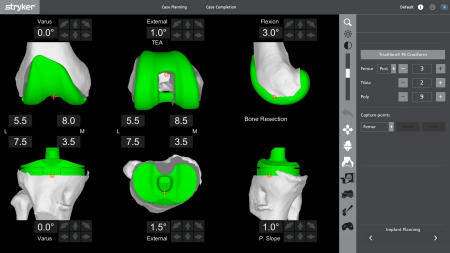
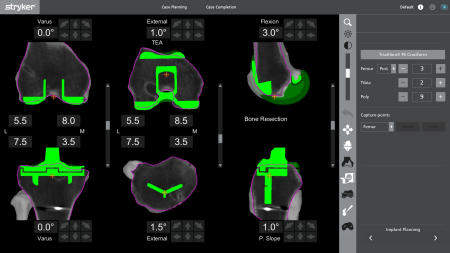
Instruments called “array”s are needed to tell the robot precisely the real time location of your knee and boney landmarks. These arrays are fixed firmly on to the bones of your leg with screws before the actual surgery, and are removed once the surgery is complete (Picture 2). After a standard surgical exposure, your surgeon defines multiple bone landmarks on the knee to describe your anatomy and the robot correlates this with your pre-op CT images and the plan. This step is called the registration, and is accurate up to 1 mm and 1 degrees (Picture 3). Once the registration is complete, the robot knows exactly where to guide the surgeon’s cutting instruments (motorized saw blades). The next step is evaluating the soft tissue balance of your knee. This is performed by your surgeon by stressing the ligaments at different positions of knee motion. The bone cuts can be revised at this stage to perfectly balance your ligaments and soft tissues. Once your surgeon is satisfied with the plan, bone cuts are made with the help of the robotic system (Picture 4).
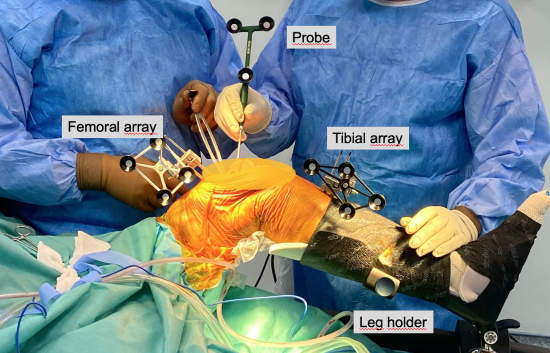
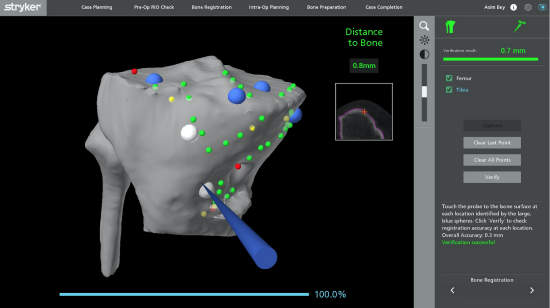
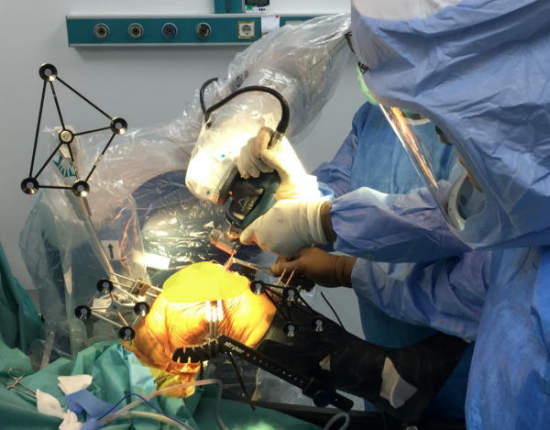
The robotic system guides your surgeon to perform the pre-planned bone cuts with a very high accuracy. The system is very safe and does not permit the surgeon to work outside the pre-determined limits. Your surgeon performs the surgery by viewing the surgical area and double checking the situation from the real time 3-D images on the computer monitor.
Once the bone cuts are made, trial implants are placed. The knee range of motion, ligament balance and stability are re-checked (Picture 5). Fine tuning of the bone cuts can be performed if needed, the system employs multiple safeguards and checks to make sure that the surgeon precisely cuts the bone according to the intended plan. The final step is the placement of your implants, your surgeon uses “bone cement” to fix the metal components to bone. A final check of stability and ligament balance is performed at the end of surgery to document that the pre operative plan has been realized accurately. The arrays are removed and closure of the surgical wound is performed.
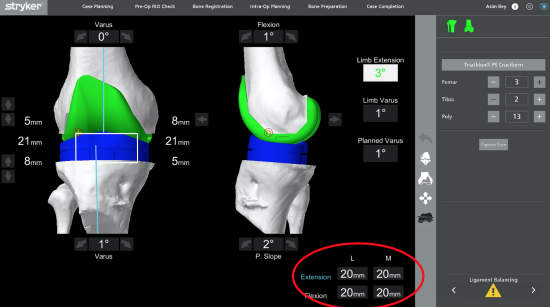
What are the advantages of robotic knee replacement?
The most important advantages of robotic knee replacement are the increased accuracy of bone cuts and better soft tissue balance compared to conventional knee replacement. The accuracy of the robot is greater than any human can consistently achieve. The patient satisfaction and long term survival of knee replacement is greatly influenced by the accurate placement of the implants and soft tissue balance, and this can be consistently achieved with robotic surgery. All comparative studies have shown that robotic surgery can achieve better accuracy compared to conventional knee replacements. The outcomes of robotic surgery and well performed conventional knee replacement are comparable at mid-term (5-10 years) follow-up. However, we believe that the increased accuracy of robotic surgery will outperform conventional knee replacement at longer term follow-up. There are studies showing that forgotten joint scores (patients feeling the knee to be nearly normal) are higher with robotic surgery, this is probably due better ligament balance.Conventional knee replacement requires a metal rod to be placed in the medullary cavity of the femoral bone to achieve the intended alignment. This might lead to small particles of fat to enter the blood stream (fat embolism) and may be problematic with patient with pre-existing heart and neurological disease. Robotic surgery does not violate the medullary canal of the femur, therefore this problem is not seen. Patients with implant in the femur due to previous fracture or long stem hip replacement can benefit from robotic surgery, since these implants do not need to be removed during robotic surgery. Preserving the canal of the femur results in less blood loss and pain after surgery, most studies have shown easier rehabilitation and shorter hospitalization after robotic surgery.
Is robotic surgery safe?
Robotic knee replacement is currently being performed in more than 300 centers around the world. More than 100.000 patients have been treated successfully with robotic surgery. The procedure has been approved by the U.S. Food & Drug Administration since 2008 for partial knees and 2016 for total knee replacement. Studies are ongoing for shoulder robotic shoulder replacement and robotic spinal surgery.What are the drawbacks of robotic knee replacement?
Robotic knee replacement is expensive. This technological innovation requires an important investment for the hospitals and necessitates expensive single use instruments for each surgery. Depending on the country, robotic knee replacement might be 2 to 3 times more expensive compared to conventional knee replacement.Unlike conventional knee replacement, a pre-operative computed tomography scan of the leg is needed for planning and execution of robotic knee replacement. This exposes the patient to additional radiation (albeit low-dose) and adds to the cost of the procedure.
The arrays used in robotic knee surgery need to be firmly fixed to bone with long screws. This requires four holes to be drilled into the bones. These arrays are removed at the end of surgery, however it may take several weeks for these holes to be filled with bone by the body. Fractures have been reported through these holes in very rare cases. The arrays and checkpoints need to be firmly fixed to bone during surgery, if they move more than 1.5 mm, the registration of bone may have to repeated and in rare cases the robotic procedure may have to be converted to a conventional knee replacement. This risk is more frequent in very elderly patients with poor bone quality.
The surgery takes longer compared to conventional knee replacement. The setup of the robotic system, bone registration and frequent checks of ligament balance during surgery increase the operative time. This may lead to 15-25 minutes increased operative time, however, this is an acceptable price to pay for increased accuracy.
For more information, please visit our Robotic Joint Replacement website.
